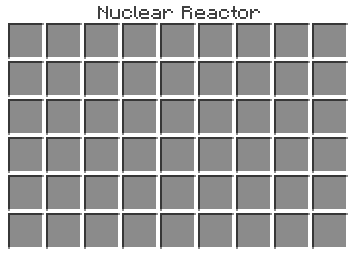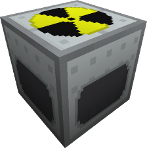Nuclear Reactor
| Nuclear Reactor | |
|---|---|
| Properties | |
| Type | Generator
|
| Stackable | Yes (64)
|
| Technical Details | |
| UU Cost | {{{uu_cost}}} |
| First appearance | ? |
| ID | IC2:{{{id}}} |
|
| |
The Nuclear Reactor is a known generator to produce EU.
With IndustrialCraft² the reactor system is fully recoded!
Instead of lame Uranium refining, you have to make a good setup for your reactor with all the reactor stuff you can find in the navigation.
But one thing wasn't completly changed: The nuclear melting.
In IC² the reactor can hold a value of heat, which is a byproduct of producing energy with Uranium Cells. This heat can be reduced by stuff like Cooling Cells , Integrated Heat Dispensers and so on.
In addition you can make your reactor bigger with Reactor Chambers. You can have 6 additional Reactor Chambers.
Recipe
GUI
 
|
This is the new GUI: (Fully upgraded with 6 additional Reactor Chambers) Don't think about using them as a mad scientist's large chest, a reactor will spit out any item that is unrelated to it's function. |
Usage
Reactors are complex and not for the faint of heart, a bad design can suddently replace your house with a nice new crater.
Reactor Terms[edit]
Here are some of the terms often use when describing a reactor and it's design.
Reactor Tick: A reactor 'ticks' once every second, this is when heat, EU generation and cooling is calculated.
Reactor Design: The pattern in which components are place within a reactor, a good design can give you nice safe energy and a bad design can spontaneously crater-ize your home and it's contents.
Full Cycle: The time it takes for a full uranium cell to be used up, 10,000 reactor ticks or 2 hours 47 mins
Uranium Pulse: Pulses occur during a reactor tick producing heat and EU for each uranium cell, uranium cells placed next to each other will interact produce multiple pulses per reactor tick.
Heat: The reactor itself and it's components can all store heat, if heat levels gets too high then components will melt and there will be a risk of a reactor meltdown. ( Boom! )
Cooling: Cooling is provided by internal components like a Cooling Cell and the outside enivronment like water. Cooling is needed to counteract the effects of heat and hopfully keep your reactor (and home) intact.
Cooldown Period: The time required for an inactive reactor to cool all the excess heat it has collected.
Reactor Hull: This is where heat goes when it's not stored in a component. The maxium heat storage is 10,000 but it can be increaced with Reactor Chambers and Integrated Reactor Plating
Reactor Class: All reactor designs can be a class like "Mark-I-O ED" or "Mark-III EB" which gives an indication of how well a design will perform.
Reactor Efficentcy: The amount of EU generated per Uranium Cell used, the more uranium cells that are placed next to each other, the higher the efficency but also higher the risk.
Breeder Reactor: A type of reactor design that produces little energy, it purpose it to recharge Depleted Isotope Cells into full Uranium Cells
Reactor Components[edit]
A list of the various components that can be used within a reactor.
Reactor Chamber: Not really an internal component, these are placed adjacent to the reactor block in order to increase the number of slots within a reactor, increase the stength of the hull (+1000) and add a small amount of cooling.
Uranium Cell: The key part of a reactor and each cell will pulse one or more times, producing some heat and 100 EU for each pulse during one reactor tick. On it's own, a cell will only pulse once (5 EU/t) but for each adjacent uranium cell it will pulse again for free, producing additional heat and packets of 100 EU. A uranium cell will last up 10,000 reactor ticks (2 hours 47 minutes), generating anywhere between 1,000,000 to 5,000,000 EU depending on the effiency of the design. Uranium cells have a chance to turn into Near-Depleted Uranium Cells when they're used up.
Cooling Cell: A single cell can store upto 10,000 heat away from the reactor hull, any more heat will cause the cell to melt. The cell will also cool 1 point of it's stored heat each reactor tick.
Integrated Reactor Plating: Plating will distribure heat from an adjacent uranium cells into surrounding cooling cells and also into other plating to be futher distributed. Distributing heat to another plating only happens once, the second plating will not distrubtute to a third plating. Plating also increases the reactor's hull strength (+100) and can store upto 10,000 heat itself if it is unable to direct it into a cooling cell, this stored heat will disipate at a rate of 0.1 per reactor tick.
Integrated Heat Dispenser: These components will attempt to balance out the levels of heat within the reactor hull, itself and any adjacent component cabable of storing heat. During each tick the dispenser can give/take upto 25 heat from the reactor hull and give/take upto 6 heat from each of the surrounding components.
For example, if a reactor hull has 120 heat stored and fresh dispenser is placed inside and surrounded by cooling cells then the dispenser will begin balancing the heat levels until the hull, itself and the cooling cell all have 20 heat each.
Near-Depleted Uranium Cell: The 'empty' state of a uranium cell, these can be made manually or have a chance of appearing when a uranium cell runs dry within a reactor. They produce 1 heat each reactor tick.
Depleted Isotope Cell: A depleted uranium cell mixed with coal dust, when placed next to a uranium cell it recharge into a full cell once again. Isotope cells produce 1 heat and will cause adjacent uranium cells to pulse an additional time each tick, this extra pulse will produce heat but not EU. Isotope cells charge much faster if the reactor is running very hot.
Re-Enriched Uranium Cell: The fully charged state of an isotope cell, it will continue to produce only 1 heat and no EU but it will no longer react with adjacent uranium cells. Combined with another coal dust to become a brand new uranium cell.
Water Bucket: When a reactor's hull has more than 4000 heat, it will evaporate the water reducing the heat level by 500 and leaving the empty bucket behind. (The reactor won't spit it out)
Ice Block: Each reactor tick, if a reactor's hull has more than 200 heat it will evaporate the 1 ice block reducing the heat level by 200.
Lava Bucket: A lava bucket will increase a reactor's hull heat level by 2,000 and the empty bucket will remain in the reactor. This is useful for 'breeder' type reactors while recharing isotope cells.
Heating and Cooling[edit]
Almost every component and the reactor itself can store heat in an effort to stave off a disater, it is upto the cooling systems (and 'you') to get rid of this accumulated heat before the reactor cannot take any more.
The reactor's own storage (known as the reactor hull) starts of at 10,000 but that can be increased by extra chambers (+1000) or placing plating into the reactor (+100). If the reactor hull reaches 50% of it's maximum heat storage then nearby water will begin to evaporate and at 85% the reactor has a change of removing itself from existance... violently.
Heat stored in components will be safely tucked away from the hull but it will need time for the cooling systems to quench it all.
The most common source of heat is uranium cells, they will produce heat for each pulse they perform. The ammount of heat depends on how many cooling components are adjacent to the cell:
| No. of Components | Heat Generated |
|---|---|
| 0 | 10 per pulse into the reactor hull |
| 1 | 10 per pulse into component |
| 2 | 8 per pulse, 4 for each component |
| 3 | 6 per pulse, 2 for each component |
| 4 | 4 per pulse, 1 for each component |
More cooling systems around a uranium cell mean less overall heat to deal with, making the reactor safer, but it also reduces the potencial amount of EU a cell can produce. Risk vs. Reward.
Depleted Isotope cells only produse 1 heat per tick themselfs, but they still react with adjacent uranium cell and make them pulse additional times.
Near-Depleted Uranium Cells and Re-Enriched Uranium Cells produce 1 heat per tick.
There are several ways to reduce a reactor's heat each tick:
|
* Both still and flowing water count. ** Torches, redstone and similar items won't count. |
* Cooling only occurs if the component in question has any heat stored. |
The maximum outside cooling possible is 33 (Reactor, 6 chambers and 20 water blocks)
If the amount of cooling availible is less than the amount of heat produced then the reactor will gradually collect heat, there are various ways to deal with this:
- Make a design that only has a slight amount of excees heat so that even when the uranium cells are used up the heat levels are still not dangerous.
- Manually drop Ice blocks and/or Water buckets into the reactor
- Apply redstone current to the reactor (or one of it's chambers), causing it to stop generating heat and EU for as long as the redstone current is active.
Heat management for a 'breeder' type reactor is different, breeders work best when running hot so it's best to make a design that has exactly the same heat and cooling amount then manually boosting the heat by adding lava buckets, removing cooling or temporarely adding extra uranium cells.
Reactors will emit smoke particles when warm and fire particles when hot, be carful when using lava buckets as the 2000 heat goes directly into the hull and the heat dispensers need time to pull all that into the cooling systems.
Reactor Classification[edit]
All reactor designs fall into a set of pre-defined categories. This makes it easier to see, at a glance, how effective a design can be when either looking up designs on the IC forums or posting a design yourself.
Mark I[edit]
Mark I reactors generate 'no excess heat each reactor tick and thus are safe to use continuously for as long as you provide it uranium. Mark I's tend have a low effiency but that's the price of a completely safe reactor.
Mark Is have two sub-classes: Mark I-I for design that do not rely in outside cooling in anyway and Mark I-O for those that do.
Mark II[edit]
Mark II designs produce a small amount of excess heat and will eventually need to be given a cooldown period to prevent the hull reaching 85% maximum heat or melting component. A Mark II must complete atleast one full cycle before encountering heat problems.
The sub-class for Mark IIs denote how many cycles the design can run before reaching critical heat levels. For example Mark II-3 will need a cooldown period after runing 3 cycles in a row. Mark IIs that can run 16 times or more get the special sub-class 'E' (Mark II-E) for almost being a Mark I.
Mark III[edit]
Mark III reactors tend to have an emphisis on effiency at the cost of safety, Mark IIIs are unable to complete a full cycle without going into meltdown and thus need to be shutdown mid-cycle in order to deal with the high amount of excess heat. This can be done manually or by using fancy redstone-fu skillz.
Mark IIIs have the additional condition that they must run atleast 10% of a cycle (16 mins 40 secs) before reaching critical heat or loseing any components.
Mark IV[edit]
Mark IVs still have to run atleast 10% of a cycle, just like Mark IIIs. The difference being that Mark IVs are allowed to lose components to over heating and that must be replaced before the reactor goes critical.
Mark V[edit]
Mark Vs are for those who want to squeeze every last scrap of EU from their uranium cells, they cannot run long without needing a cooldown period. You better have great restone timers skills or else you'll never be able to turn your back on these things.
Additional Suffixes[edit]
As well as being Mark I to V, reactor designs also have one or more suffixes to better inform people about their performance.
Single Use Coolants: Reactors that rely on a supply of Ice and/or water buckets in order to mantain it's classification should be suffixed with '-SUC'
Effiency:' To calculate effiency, take the number of uranium pulses a design makes per tick then divide it by the number of uranium cells it possess.
The number provided will show the effiency rating a design has:
| Number | Rating |
|---|---|
| Exactly 1 | EE |
| Greater than 1 but less than 2 | ED |
| 2 or greater but less than 3 | EC |
| 3 or greater but less than 4 | EB |
| 4 or greater | EA |
Breeder: This suffix is for designs that also recharges isotope cells. Isotope cells charge up faster when the reactor runs hot meaning heat management is important for them, so there are three breeder types:
Negitive-Breeders slowly lose heat over time and will need heat to be manually added, or they can be left for a safe slow way to recharge isotopes.
Equal-Breeders have exactly the same heat generation as they do cooling ability and usualy only require a user to manual boost the reactor's heat level at the begining.
Possitive-Breeders gain heat over time and will require more precise cooldown management for the reactor to remain hot.
Reactors whose sole purpose is to recharge cells may not even have a 'Mark' classification and are simply called Breeders instead, with the effiency/SUC suffix added.
Example Classifications[edit]
Mark II-2 EC: A reactor design that can run two full cycles before needing a cooldown period, producing atleast 2 pulses per uranium per reactor tick on average.
Mark I-O EE: A reactor design that can run continously, but relies on outside cooling and only produces one pulse for each uranium.
Mark II-E-SUC EC: A reactor that can run atleast 16 times before needing a cooldown, relying on a supply of ice or water and has average effiency.
Mark II-1 ED Positive-Breeder: A reactor with recharging capabilites but can only run one full cycle before needing a cooldown.
Breeder EA: A heat-neutral reactor designed for the sole purpose of recharging isotope cells, each uranium cell is charging 3 or more isotope cells.
Tips and Tricks[edit]
Here are a few tips and things to look out for when using a reactor.
- There is a Thermometer addon on the [forum] that can be useful for those want to closely monitor heat levels.
- Redstone timers can turn even Mark Vs into self regulating reactors, but if you're not the redstone equivilant of "The One" then you might want to make use of a redstone enchancing mod like RedPower for example.
- Heat dispensers can only draw 6 heat out of a component per reactor tick, so carful to look out for components that seem to be holding much more heat than all the others and try to fix the problem.
- While the reactor hull's maximum heat tolerance can be increased, all other components are fixed at 10,000. So even though a reactor can surive 10,000+ heat, heat dispensers will still pull that heat into components and melt them all.
| |||||||||||||||||||||||||||||||||||||||||||||||||||||||||||||||||||||||||||||||||||||||||||||||||||||||||||||||||||||||||||||||||||||||||||||||||||||||||||||||||||||||||||||||||||||||||||||||||||||||||||||||||||||||||||||||||||||||||||||||||||||||||||||

